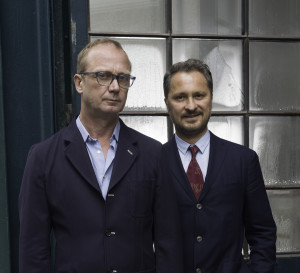Austrian Pavilion
La Biennale di Venezia 2015
Heimo Zobernig
Commissioner: Yilmaz Dziewior
Through his professorship at the Academy for Fine Arts in Vienna, where he has taught for the last 14 years, Heimo Zobernig continues to influence subsequent generations. His exhibition activities range from repeated participation in major events such as the Biennale di Venezia (1988 & 2001), the documenta in Kassel (1992 & 1997), and Skulptur Projekte Münster (1997) to extensive individual exhibitions in renowned institutions like the Palacio de Velázquez/Museo Reina Sofía in Madrid (2012), Kunsthaus Graz (2013), Mudam Luxembourg, and the Kestnergesellschaft in Hannover (both 2014) – to name just a selection from the last three years.
Heimo Zobernig’s work is marked by its high level of precision in terms of both form and content. He often succeeds in involving the observer both intellectually and sensually at the same time. His spectrum ranges from drawing and painting through installation and sculpture to video and spatial settings of a practical nature. Already in his early years, Heimo Zobernig had a firm grasp of how to question the basic premises of art both critically and playfully, by using the exhibition and/or the catalog or book in itself as a medium of his analytical reflection. In this sense, the individual building blocks of his art became his actual oeuvre. Hence, he exposes the mechanisms of the art system, addresses hierarchies and examines concepts both for their concrete and metaphorical meanings. All the more impressive is how he succeeds in negotiating these issues in the form of what might almost be called classical, apparently autonomous canvases and sculptures, or by means of concrete architectural interventions and installations.
Heimo Zobernig will skillfully combine both approaches for the Austrian Pavilion, which is based on a spatial concept by Robert Kramreiter and was built in 1934 by Josef Hoffmann. Both spatial intervention and independent work of art will enter into a combination as equal, reciprocally commentating elements of his Venice contribution. No less than the concrete room, the situation of the Biennale itself is a starting point for Heimo Zobernig’s deliberations. How can a meaningful contribution be made in an environment based on nation-state representations and in which each voice competes for the most attention? What effects make sense in such a context? These questions also play a role in Heimo Zobernig’s concept for Venice. And the Austrian Pavilion, with its equally classical and modern language of form, offers an ideal space for this purpose.
Yilmaz Dziewior, Bregenz, September 2014
Image: Heimo Zobernig and Yilmaz Dziewior. Photo Georg Petermichl, Courtesy Austrian Pavilion


